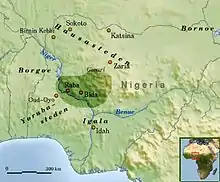Nupe people
The Nupe people, traditionally called the Tapa by the neighbouring Yoruba, are a Volta-Niger ethnic identity and historic nation native to Middle Belt Nigeria, and are the dominant ethnicity in Niger State, an important minority in Kwara State and present in Kogi State as well in the Federal Capital Territory.[1][2]
 | |
| Total population | |
|---|---|
| c. 4.5 million | |
| Regions with significant populations | |
| Languages | |
| Nupe | |
| Religion | |
| Related ethnic groups | |
| Gbagyi, Igala, Yoruba, Ebira, Kambari, Kamuku, Bissa, Bariba, Dukawa and others |
History
The Nupe trace their origin to Tsoede who fled the court of Idah and established a loose confederation of towns along the Niger in the 15th century.[3][4] The proximity of Nupe to the Yoruba Igbomina people in the south and to the Yoruba Oyo people in the southwest led to cross-fertilization of cultural influences through trade and conflicts over the centuries.[5]
Population and demography
There are probably about 4.5 million nupes, principally in Niger State. The Nupe language is also spoken in Kwara, Kogi and Federal Capital Territory. They are primarily Muslims, with a few Christians and followers of African Traditional Religion. The nupe people have several local traditional rulers. The Etsu Nupe (Bida) is not pure nupe, his great grandfather from his father side is Fulani while the family of his mother was complete nupe. His great grandfather from his father side came to rule Bida in the 1806. They have no present capital, although they were originally based at Rabah and only moved to Bida in the nineteenth century.[6]

Traditions, art and culture
The nupe people have various traditions. Many practices have changed as a result of The movements started by Usman Dan Fodio jihad of the 19th century, but they still hold on to some of their culture. Many nupe people often have scarification on their faces (similar to an old Yoruba tradition), some to identify their prestige and the family of which they belong as well as for protection, as well as jewelry adornment. But these traditions are dying out in certain areas. Their art is often abstract. They are well known for their wooden stools with patterns carved onto the surface.[7][8]
The nupe were described in detail by the ethnographer Siegfried Nadel, whose book, Black Byzantium, remains an anthropological classic.
Examples of Nupe art
 Burtu wooden mask, used during bird hunting; Museum of Ethnology, Vienna. The hunter would tie the mask around his head and imitate the bird's movement.
Burtu wooden mask, used during bird hunting; Museum of Ethnology, Vienna. The hunter would tie the mask around his head and imitate the bird's movement. Carved door; circa 1920–1940; wood with iron staples; Hood Museum of Art.
Carved door; circa 1920–1940; wood with iron staples; Hood Museum of Art. Wooden oval stool with incised carving; Los Angeles County Museum of Art.
Wooden oval stool with incised carving; Los Angeles County Museum of Art.
| Wikimedia Commons has media related to Nupe people. |
Notable Nupe people
- Shaikh Ahmad Lemu (OON, OFR), Islamic Scholar (b.1929 - d.2020)
- Hon. Justice Idris Legbo Kutigi (OFR, GCON), Nigeria Lawyer and Judge (b.1939 - d.2018)
- Alhaji Alfa Darachita (d. 2020)
- Mohammed Umar Bago, politician (b.1974)
- Muhammad Bima Enagi, politician (b.1959)
- Shehu Ahmadu Musa, politician (b.1935- d.2008)
- Shaaba Lafiaji, politician
- Suleiman Takuma, journalist and political leader (b1934- d.2001)
- Sam Nda-Isaiah, political columnist (b.1962 -d.2020)
- Isa Mohammed Bagudu, third republic politician (b. 1948)
- Zainab Kure, politician
- Abdulkadir Kure, politician (b.1956- d. 2017)
- Aliyu Makama, Northern acting premiere (b.1905- d.1980)
- H.R.H. Alhaji Yahaya Abubakar (GCFR), Etsu-Nupe; Traditional ruler (b.1952)
- Fatima Lolo, musician (b.1891 - d.1997)
- Dr Alfa Saadu, physician (b.1952 - d.2020)
References
- Nadel, S. F. (2018), "The Nupe Creed", Nupe Religion, Routledge, pp. 1–37, doi:10.4324/9780429487446-1, ISBN 978-0-429-48744-6
- Yahaya, Mohammed Kuta (2003). "The Nupe People of Nigeria". Studies of Tribes and Tribals. 1 (2): 95–110. doi:10.1080/0972639x.2003.11886489. ISSN 0972-639X.
- Mason, Michael (1975). "The Tsoede Myth and the Nupe Kinglists: More Political Propaganda?". History in Africa. 2: 101–112. doi:10.2307/3171467. ISSN 0361-5413. JSTOR 3171467.
- Lawal, Babatunde, 1942-. Tsoede, Sango, and the Nupe bronzes. OCLC 57969198.CS1 maint: multiple names: authors list (link)
- Forde, Cyril Daryll. (1955). The Nupe. OCLC 35809832.
- Katcha, Abubakar. (1978). An exploratory demographic study of the Nupe of Niger State : the case of Sakpe village. Australian National University. ISBN 0-909150-60-5. OCLC 5021109.
- Nadel, S. F. (2018-09-03). Nupe Religion. doi:10.4324/9780429487446. ISBN 9780429487446.
- Nadel, S. F. (Siegfried Frederick), 1903-1956, author. (22 August 2018). Nupe religion. ISBN 978-1-138-59670-2. OCLC 1061313933.CS1 maint: multiple names: authors list (link)
Sources
- " History Of Nupe People", NupeBaze.com.ng 2019.
- Blench, R.M. (1984) "Islam among the Nupe." Muslim peoples. (ed. 2) Westview Press, Boulder, Colorado.
- Forde, D. (1955) The Nupe. pp. 17–52 in Peoples of the Niger-Benue Confluence. IAI, London.
- Ibrahim, Saidu 1992. The Nupe and their neighbours from the 14th century. Ibadan: Heinemann Educational books.
- Madugu, George I. (1971) The a construction in Nupe: Perfective, Stative, Causative or Instrumental. In Kim C-W. & Stahlke H. Papers in African Linguistics, I' pp. 81–100. Linguistic Research Institute, Champaign.
- Perani, J.M. (1977) Nupe crafts; the dynamics of change in nineteenth and twentieth century weaving and brassworking. Ph.D. Fine Arts, Indiana University.
- Stevens, P. (1966) Nupe woodcarving. Nigeria, 88:21-35.
- The Nupe People of Nigeria by Mohammed Kuta Yahaya. Nigeria, 95:1-2